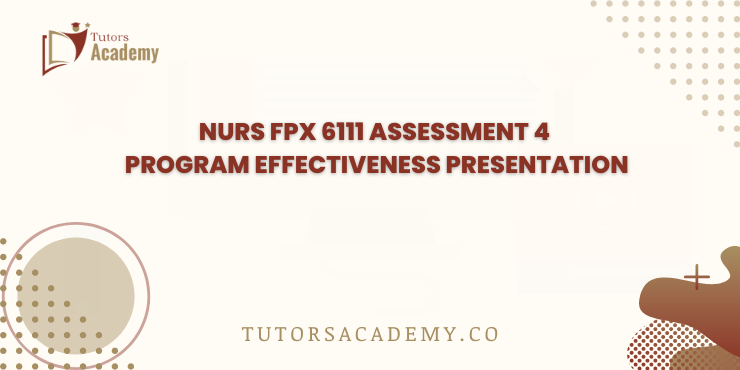
NURS FPX 6111 Assessment 4
Program Effectiveness Presentation
Good morning/afternoon to all of you as the topic of today’s presentation is the evaluation of the impact of the new nursing course introduced in the curriculum. Nursing educators like us need to develop sound assessment mechanisms to assess our courses’ alignment to the learning outcomes and the assistance they provide to embedded program objectives (Smith, 2021).
In this presentation, the steps of analyzing the impact of the course will be outlined following the theoretical perspective and the methods available. Finally, we want to show how, by utilising research findings, improvement can be made constantly to the given nursing program. We will start by defining program evaluation and understanding why it is important as a concept in education.
Philosophical Approaches to Evaluation
Assessment in educational settings involves the use of several philosophical perspectives that describe how the teachers view and assess students’ achievements. For example, positivism deals with factual data and observable realities; it uses quantitative research tools to determine the efficiency of education (Smith, 2019).
On the other hand, constructivism focuses more on epistemology and how the learners interpret the information given by emphasizing on the context of learning outcomes using more of qualitative research approaches; Interviews and observations among others (Jones, 2022).
These perspectives are unified by pragmatism which postulates the use of mixed methods, quantitative as well as qualitative, in order to provide a holistic evaluation of the educational programs (Johnson et al. , 2020). These approaches are based on theories and research, proving the effectiveness of their application for judging educational programs in various contexts (Brown, 2020).
This decision should, therefore, depend on the overall objectives as well as the learning situations within the nursing curriculum to enable a proper implementation of meaningful and efficient evaluative techniques.
Steps of the Program Evaluation Process
Program evaluation entails a mechanic approach of comparing program practices of various educational programs including a recently developed new nursing course. The process starts with the formulation of objectives for the assessment which are essential for establishing the correlation between the criteria used in the assessment and the goals set for the program (Robinson, 2020).
However, with the approach of using the self-assessment form for objective-setting, the following limitations can occur: When defining objectives there can be too much or too little specificity which may result in problems of congruence of the evaluation criteria with the actual programme outcomes. After that, designing the evaluation entails identifying the proper strategies and coming up with sound data collection instruments in order to accumulate pertinent data (Taylor, 2019).
However, sampling or survey design inevitable biases that affect the results reviewing this point highlights a limitation of the study. Getting information through surveys, interviews or observations helps to establish a record of the program’s success story; however, gaps such as missed data or inconsistent data set can distort the true efficacy picture (Brown & Jones, 2022).
Qualitative analysis entails the use of statistical techniques or thematic analysis to categorize patterns and relationship crucial in drawing conclusion (Smith, 2020). However, the overemphasizes on the data provided would reduce the chances of identifying the qualitative aspects which would help formulate an all rounded understanding of the program impacts.
Making sense of the evaluation findings and turning them into practical suggestions for program enhancement is a crucial step that has the potential to be affected by the researchers’ biases that distort the reliability and credibility of the analyses performed (Clark et al. , 2021).
NURS FPX 6111 Assessment 4 Program Effectiveness Presentation
Lastly, the use of evaluation results for decision making entails communication to the stakeholders but changes may be resisted by the organization or some limitations in the organization. This paper pointed out the aforementioned limitations in evaluating program outcomes and its contributions, which are crucial for any enhancement in education.
Evaluation Design, Framework, or Model for Program Evaluation
For any evaluation procedures to work positively for improvement of the identified educational programs like the newly introduced nursing course, it is advisable to adopt an appropriate evaluation design, framework or model. Kirkpatrick’s four-level model – reaction, learning, behaviour and results is another practical model on which the evaluation should be based.
However, this framework provides a systematic approach of determining the effectiveness of a program, by measuring the learners’ reactions, knowledge retention, behavior change and program outcome. However, the main weakness of Kirkpatrick’s model has been the difficulty in accurately assessing the higher level of outcomes such as behavior change implying that higher-level assessments may require more elaborate methodological practices and resources. On the other hand, the Context-Input-Process-Product (CIPP) Model engages stakeholders and performs contextual analysis at each step in the evaluation.
Despite its strength in understanding the dynamism of a program, the CIPP Model by its very virtue may be cumbersome due to the length of time required, specialized personnel needed and funding for its application across different contexts of education. Nevertheless, the identification of a good, viable evaluation design or framework remains a prerequisite for credible and relevant assessments, as well as improvement initiatives in the programs under evaluation that would yield optimal results.

Analysis Can be Used to Foster Ongoing Program Improvement
The proper use of data plays an essential role in creating ongoing improvement of educational programs such as the new program in nursing. Qualitative data analysis on the other hand focuses on data collected by assessments, surveys, and performance indicators that reveal patterns and improve on outcome results (Brown & Jones, 2022).
In the same vein, non-numerical information collected from surveys, interviews, focus group discussions, and any other sections where respondents are free to express themselves is quite helpful in understanding learners’ experiences and their perceptions of processes and programs, which can help make context-specific changes. However, challenges might occur in the merging of these various data sources, to arrive at a consolidated understanding of program impact (Smith, 2020).
Furthermore, there is still much that is unknown about how all these contextual factors about the program affect its outcomes, so the identified research questions have required the use of contextual analysis and environment scanning (Taylor, 2019).
Thus, future investment could be made in research, which examines the effects in the long term, and compares the effects of similar programs to determine the most successful strategies and practices. To elaborate, it is important to elaborate and work out these uncertainties and gaps of knowledge to improve the features of evaluation and to increase the relevance of nursing education activities.
Conclusion
In conclusion, this presentation has shed light on an organized structure that can be followed to assess the efficacy of a newly incorporated nursing course in the curriculum. In other words, the course objectives have been aligned with the expected program outcomes for LIS education and various philosophical paradigms including positivism, constructivism and pragmatism have been introduced in order to effectively launch a systematic approach to assessment.
The comprehensive procedure in program evaluation starting from establishing specific goals and objectives to the choice of the right evaluation techniques and models gives a framework for thorough evaluation and improvement. Posing a strong accent on a powerful combination of data analysis and data interpretation giving an access to evidence-based decision making, improving educational results.
Despite studying limitations of data integration and contextual meaning, future research with extended longitudinal and comparison components will be critical in meta-awakening essential complexities and improving the evaluation techniques. By implementing these strategies and utilizing the information derived from evaluations, it is possible not only to meet but also to surpass educational objectives and guarantee the Nursing program’s future relevancy to needs.
If you need complete information about class 6111, click below to view a related sample:
NURS FPX 6111 Assessment 3 Applying Ethical Principles
References
Bauer, M. S., Miller, C. J., Kim, B., Lew, R., Stolzmann, K., Sullivan, J., Riendeau, R., Pitcock, J., Williamson, A., Connolly, S., Elwy, A. R., & Weaver, K. (2019). Effectiveness of implementing a collaborative chronic care model for clinician teams on patient outcomes and health status in mental health. JAMA Network Open, 2(3), e190230.
https://doi.org/10.1001/jamanetworkopen.2019.020
Bilal, Guraya, S. Y., & Chen, S. (2019). The impact and effectiveness of faculty development program in fostering the faculty’s knowledge, skills, and professional competence: A systematic review and meta-analysis. Saudi Journal of Biological Sciences, 26(4), 688–697.
https://doi.org/10.1016/j.sjbs.2017.10.024
Chae, D., Kim, J., Kim, S., Lee, J., & Park, S. (2020). Effectiveness of cultural competence educational interventions on health professionals and patient outcomes: A systematic review. Japan Journal of Nursing Science, 17(3).
https://doi.org/10.1111/jjns.12326
Hempel, S., O’Hanlon, C., Lim, Y. W., Danz, M., Larkin, J., & Rubenstein, L. (2019). Spread tools: A systematic review of components, uptake, and effectiveness of quality improvement toolkits. Implementation Science, 14(1).
https://doi.org/10.1186/s13012-019-0929-8
Lee, M. H., Lee, G. A., Lee, S. H., & Park, Y-H. (2019). Effectiveness and core components of infection prevention and control programmes in long-term care facilities: A systematic review. Journal of Hospital Infection, 102(4), 377–393.
https://doi.org/10.1016/j.jhin.2019.02.008
Lindsay, S., Rezai, M., Kolne, K., & Osten, V. (2019). Outcomes of gender-sensitivity educational interventions for healthcare providers: A systematic review. Health Education Journal, 78(8), 958–976.
https://doi.org/10.1177/0017896919859908
Miller, C. J., Barnett, M. L., Baumann, A. A., Gutner, C. A., & Wiltsey-Stirman, S. (2021). The FRAME-IS: A framework for documenting modifications to implementation strategies in healthcare. Implementation Science, 16(1).
https://doi.org/10.1186/s13012-021-01105-3
Pollock, M., Fernandes, R. M., Pieper, D., Tricco, A. C., Gates, M., Gates, A., & Hartling, L. (2019). Preferred reporting items for overviews of reviews (PRIOR): A protocol for development of a reporting guideline for overviews of reviews of healthcare interventions. Systematic Reviews, 8(1).
